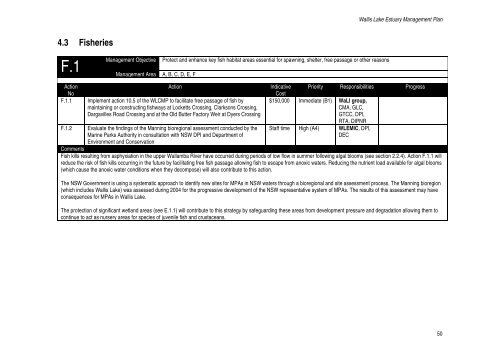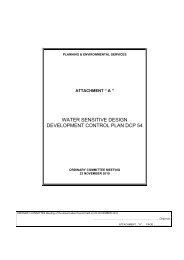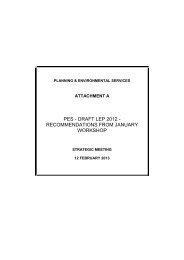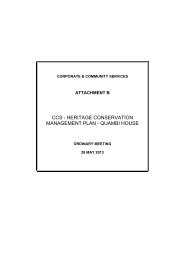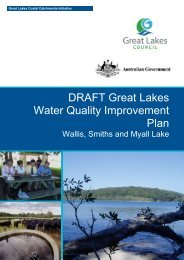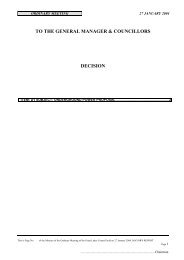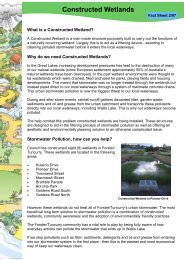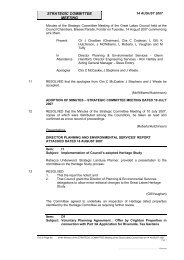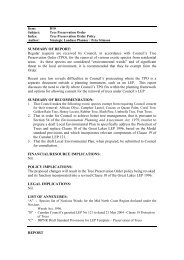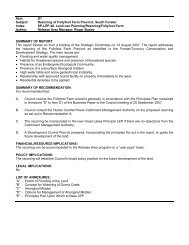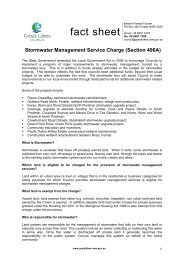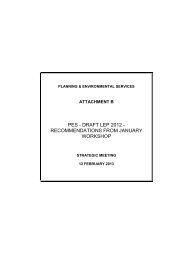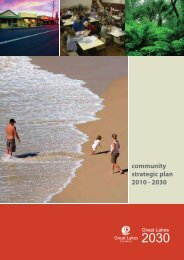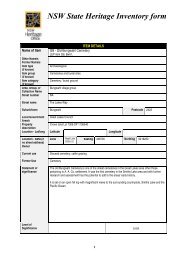13.2 The Wallis Lake Estuary Management Committee - Great Lakes ...
13.2 The Wallis Lake Estuary Management Committee - Great Lakes ...
13.2 The Wallis Lake Estuary Management Committee - Great Lakes ...
Create successful ePaper yourself
Turn your PDF publications into a flip-book with our unique Google optimized e-Paper software.
<strong>Wallis</strong> <strong>Lake</strong> <strong>Estuary</strong> <strong>Management</strong> Plan<br />
4.3 Fisheries<br />
F.1<br />
<strong>Management</strong> Area A, B, C, D, E, F<br />
<strong>Management</strong> Objective<br />
Protect and enhance key fish habitat areas essential for spawning, shelter, free passage or other reasons<br />
Action<br />
No<br />
F.1.1<br />
F.1.2<br />
Action<br />
Implement action 10.5 of the WLCMP to facilitate free passage of fish by<br />
maintaining or constructing fishways at Locketts Crossing, Clarksons Crossing,<br />
Dargavilles Road Crossing and at the Old Butter Factory Weir at Dyers Crossing<br />
Evaluate the findings of the Manning bioregional assessment conducted by the<br />
Marine Parks Authority in consultation with NSW DPI and Department of<br />
Environment and Conservation<br />
Indicative<br />
Cost<br />
Priority Responsibilities Progress<br />
$150,000 Immediate (B1) WaLI group,<br />
CMA, GLC,<br />
GTCC, DPI,<br />
RTA, DIPNR<br />
Staff time High (A4) WLEMIC, DPI,<br />
DEC<br />
Comments<br />
Fish kills resulting from asphyxiation in the upper Wallamba River have occurred during periods of low flow in summer following algal blooms (see section 2.2.4). Action F.1.1 will<br />
reduce the risk of fish kills occurring in the future by facilitating free fish passage allowing fish to escape from anoxic waters. Reducing the nutrient load available for algal blooms<br />
(which cause the anoxic water conditions when they decompose) will also contribute to this action.<br />
<strong>The</strong> NSW Government is using a systematic approach to identify new sites for MPAs in NSW waters through a bioregional and site assessment process. <strong>The</strong> Manning bioregion<br />
(which includes <strong>Wallis</strong> <strong>Lake</strong>) was assessed during 2004 for the progressive development of the NSW representative system of MPAs. <strong>The</strong> results of this assessment may have<br />
consequences for MPAs in <strong>Wallis</strong> <strong>Lake</strong>.<br />
<strong>The</strong> protection of significant wetland areas (see E.1.1) will contribute to this strategy by safeguarding these areas from development pressure and degradation allowing them to<br />
continue to act as nursery areas for species of juvenile fish and crustaceans.<br />
50


